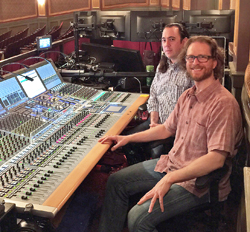
Currently playing at Broadway’s beautifully restored Lyric Theatre in the heart of Times Square, On the Town tells the story of three wide-eyed sailors on a whirlwind musical tour of the city that never sleeps. To ensure that both vocal and instrumental performances are their very best, On the Town is mixed on an Aurus digital console with signal management handled by Nexus and Nexus Star routers from Berlin, Germany-based Salzbrenner StageTec Mediagroup.
Yonkers, NY-based Sound Associates, a design / build provider of professional audio and video systems for a wide range of applications, coordinated the rental of the StageTec equipment for On the Town. Greg Reif, project supervisor at Sound Associates, oversees all production system builds and facilitates stock and purchasing for all shows from bid through installation. Patrick Pummill, production sound engineer for On the Town sat down with Greg to discuss the placement of the StageTec equipment and how it was implemented for use with On the Town.
“We took delivery of our StageTec equipment in early August,” Reif reports. “Being that the Aurus console’s primary use will be in Broadway theatres for mixing live Broadway musicals, it was critically important that the board be intuitive, fast, and reliable because an operator/engineer on this type of project doesn’t have a spare moment to hunt for a control or contend with several button presses just to get to that control. Any time spent thinking about how to get to a necessary EQ setting or Gain setting is time not spent on the mix—potentially leading to missed line pick-ups.”
“And speaking of controls,” Pummill continues, “the encoders on the Aurus are extremely accurate and pleasing to use. The indented rotary encoders allow for exacting, tiny adjustments as well as large sweeping changes. One single click changes the value by one step. Conversely, a faster spin changes the value by a much larger degree. This behavior is very natural and, because of this, adjustments become second nature very quickly. This same design approach can be said of the faders as well. The fader is the most used encoder on the desk, and it is clear that StageTec‘s design team put the same enormous amount of thought into this behavior as well. Mixing a musical requires many tiny adjustments. The faders are constantly moving, so the 1/4 dB step over the entire range of the fader is no small accomplishment.”
Pummill has also been impressed with the Aurus console’s ability to adapt to the nature of any given project. “As this console will be used for many musicals in different theatres over its lifetime, its high level of customization—like the ability to change the board’s channel layout or bussing structure—will prove to be an invaluable asset. Different sound designers and engineers have different workflows and preferences. In this regard, the Aurus is very adaptable and this attribute really sets it apart in the crowded market for mixing consoles.”
StageTec Nexus and Nexus Star routers are handling signal management at the theatre. Here, too, Pummill has been very impressed with the equipment’s performance. “We use fiber to connect the three base devices to the Star Router and fiber also connects the Aurus to its controller cards in the Star Router,” he explained. “This has significantly reduced the amount of copper wire that has to be fished through crawl spaces, catwalks, and plenums. A small run of fiber has replaced a three to four inch bundle of multicore snakes. In addition, the Nexus design allows any input to patch to any output anywhere in the system, regardless of which base device they are on, meaning that an audio tech working backstage can quickly and easily monitor any input in the system. This approach also enables the physical microphone inputs to be closer to the sound sources—like you would have in an orchestra pit.”
The show’s RF monitor system is also heavily influenced by StageTec engineering. “StageTec created a rack mounted listening station for monitoring the thirty wireless mics used on the show,” says Reif. “It’s basically a 3RU unit that contains several rows of illuminated buttons as well as a headphone amplifier. Using the Logic functions built into the Nexus—along with an XRI card—we’re able to program each button to patch one of the wireless mic inputs to an output on the headphone amplifier. This gives the technician responsible for maintaining the wireless mics the ability to instantaneously listen to each of the actors without disturbing the mixer out front. It’s kind of like having an outboard PFL of the console.”
Before turning his attention to other business, Pummill offered these parting thoughts on his StageTec experience, “The physical layout of the Aurus is very similar to most large format analog consoles, so when one walks up to the desk for the first time, there is an immediate familiarity that is comforting. This types of intuitive design, combined with StageTec’s responsive and thorough support, makes working with the equipment that much more assuring. Sound for musical theatre is a world of almost infinite variables. Having the Nexus and Aurus in the mix eliminates so many of those variables that we are better able to focus on the music, and that’s what it’s ultimately all about.”
